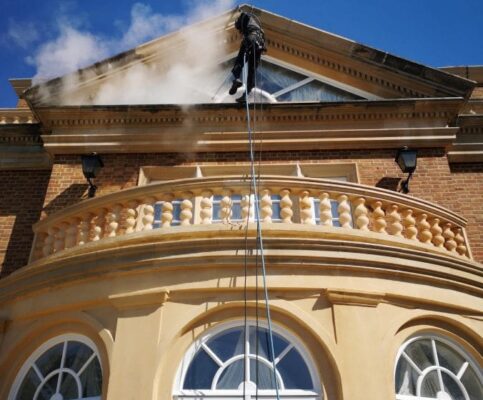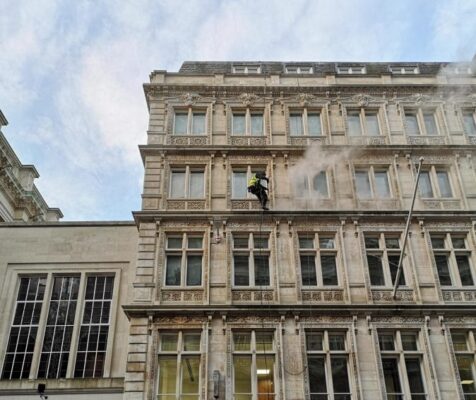View More SErvices Contact Us
Facade Cleaning in Clerkenwell
Cleaning building facades from top to bottom, no matter how tall your building.
Natural stone facade cleaning in Clerkenwell can be accessed and cleaned efficiently and effectively by using rope access methods. Using this method, the need for local authority permits is totally eradicated, allowing works to proceed immediately. Using professional stone cleaning equipment we can roll back the years to make your building look like new.
Brick cleaning
Brick buildings become dirty as much as any other building. We will not only clean away the dirt and grime, we can revitalise the colour. Using a range of bio-degradable chemicals, we can restore the colour of red or yellow bricks.
Contact UsGlass facade cleaning in Clerkenwell
Glass facade cleaning in Clerkenwell takes place by abseilers using traditional window cleaning tools. External windows, internal atriums, after builders cleaning or regular maintenance cleans, our abseilers are experienced in all manner of glass cleaning.
Contact UsAluminium cladding cleaning
Aluminium cladding in Clerkenwell can become extremely dirty over time. Warehouses that have many lorries coming and going will become soiled with traffic film. Using our steam cleaning systems, this grime is washed away leaving a lasting first impression for your visitors.
Contact UsOur services
Rope Access Facade Cleaning Services for Clerkenwell And Surrounding Counties

Residential property Stone Facade Cleaning
Façade cleaning at this residential property in Clerkenwell, which was not of any great height but, had no access for other forms of access equipment. Abseiling was the solution and the results were outstanding.

Stone Steam Cleaning in London
This beautiful natural stone building was looking tired from the day to day London traffic. Rope access was seen as the most cost-effective method of access.

Concrete Facade Cleaning in Clerkenwell
This car park in Essex was filthy. It hadn’t been cleaned, ever. As the access to three elevations was extremely tight, abseiling was the only method that could achieve the results.

Facade Cleaning in Clerkenwell
A new acquisition for our client needed a freshen up. Out of hours abseiling was the best way to clean this building in the heart of the City of London.
Brick colour restoration
Before colour restoration
This client requested a test patch before assigning us the job of cleaning their building. We carried this out with amazing results.
After colour restoration
These are the pictures of the test patch that we sent to the client. Her reaction was simply ‘WOW’. That’s the perfect response for us.
Torik Stone Cleaning System Features
150 degrees centigrade steam cleaning power
Provides a continues flow of superheated water to penetrate stone and deep clean, removing organic growth & ground in dirt.
We use Tensid (uk) Ltd
Providers of specialist cleaning equipment and specialist cleaning chemicals to professionals.
Get In Touch
Fill in the form below and we’ll be in touch within 24hrs of receiving your message.
Facts About Clerkenwell
Clerkenwell History
The Monastic Order of the Knights Hospitallers of St John of Jerusalem had its English headquarters at the Priory of Clerkenwell. St John’s Gate survives in the rebuilt form of the Priory Gate. Its gateway, erected in 1504 in St John’s Square, served various purposes after the Dissolution of the Monasteries. For example, it was the birthplace of the Gentleman’s Magazine in 1731.
In modern times the gatehouse again became associated with the order and was in the early 20th century the headquarters of the St John Ambulance Association. An Early English crypt remains beneath the chapel of the order, which was otherwise mostly rebuilt in the 1950s after wartime bombing. The notorious deception of the “Cock Lane Ghost”, in which Johnson took great interest, was perpetrated nearby.
General Info
Clerkenwell was an ancient parish from the mediaeval period onwards, and now forms the south-western part of the London Borough of Islington. The well after which it was named was rediscovered in 1924. The watchmaking and watch repairing trades were once of great importance.
Goswell Street formed the eastern boundary of the Clerkenwell parishes, with the River Fleet, now buried beneath Farringdon Road and other streets, forming the western boundary with Holborn and, in part, St Pancras. This western boundary with both neighbouring areas is now used as part of the London Borough of Islington’s western boundary with the London Borough of Camden.



